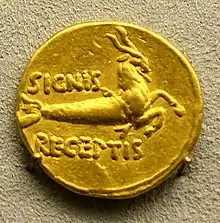Sea goat
The sea goat is a legendary aquatic animal described as a creature that is half goat and half fish.[2]
 | |
| Grouping | Legendary creature |
|---|---|
| Sub grouping | Hybrid |
| Region | Greece, Israel, Mesopotamia |
The constellation Capricornus was commonly imagined as a type of sea goat. This has been done since the Bronze Age within Mesopotamia. Then the Babylonians used MUL SUḪUR.MAŠ, 'the goat fish', to symbolize the god Enki.[3][4]
Greek interpretation
The Greek interpretation of the sea goat comes from the introduction of the Babylonian zodiac. In an attempt to codify the constellation Capricorn within the Greek pantheon, two myths were used as an explanation. One being that the constellation is Amalthea, the goat that raised Zeus. As thanks for caring for him as a child, Zeus places her amongst the stars.[5] The other being that the sea goat is the wilderness god Pan. The myth goes that Zeus jumped into the river to escape the monster Typhon. He tries to turn himself in to fish while jumping into the river, but he moves too quickly and only his lower half becomes that of a fish. Zeus then engages in combat with the monster. Zeus defeats him, but not without Typhon pulling the muscles out of Zeus’ legs. With the help of Hermes, Pan replaces the damaged muscles. As a reward for healing him, Zeus placed Pan in the sky as Capricorn.[6]
Jewish tradition
In Jewish oral history, mentions of sea goats also crop up. Stated in the stories, once the time comes all the creatures of the sea must offer themselves to the monster leviathan. It is purported that a sailor once encountered a sea goat while far out on the ocean. On its horns the words "I am a little sea-animal, yet I traversed three hundred parasangs to offer myself as food to the leviathan" were found carved.[7]
See also
References
- Tamsyn Barton (1995). "Augustus and Capricorn: Astrological Polyvalency and Imperial Rhetoric". The Journal of Roman Studies. Society for the Promotion of Roman Studies. 85: 47.
- "The Capricorn goat/sea goat". Mythology. Gods and Monsters.
- Rogers, John H. (1998). "Origins of the ancient constellations: I. The Mesopotamian traditions". Journal of the British Astronomical Association. 108: 9–28. Bibcode:1998JBAA..108....9R.
- Espak, Peeter (2006). Master's Thesis (PDF) (Masters). p. 104.
- Hatziminaoglou, Y.; Boyazoglu, J. (February 2004). "The goat in ancient civilisations: from the Fertile Crescent to the Aegean Sea". Small Ruminant Research. 51 (2): 123–129. doi:10.1016/j.smallrumres.2003.08.006. ISSN 0921-4488.
- Brown, Douglas (March 1999). "Legends of the Earth, Sea, and Sky: An Encyclopedia of Nature Myths99142Tamra Andrews. Legends of the Earth, Sea, and Sky: An Encyclopedia of Nature Myths. Santa Barbara and Oxford: ABC‐Clio 1998. xiii + 322 pp, ISBN: 0 87436 963 0 £39.95". Reference Reviews. 13 (3): 19–19. doi:10.1108/rr.1999.13.3.19.142. ISSN 0950-4125.
- Louis Ginzberg. (1909) Legends of the Jews. Entries: Vol I, "The Creation of the World: The Sixth Day" and Vol IV, "Elisha and Jonah: Jonah in the Whale".
